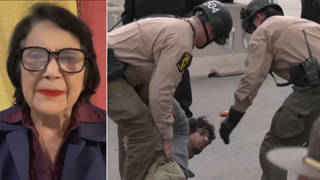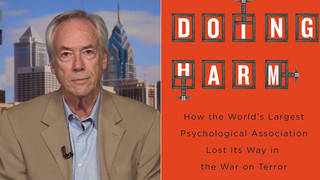
Guests
- Dr. Steven Reisnerfounding member of the Coalition for an Ethical Psychology and psychological ethics adviser to Physicians for Human Rights.
- Alfred McCoyprofessor of history at the University of Wisconsin-Madison. He is the author of A Question of Torture: CIA Interrogation, from the Cold War to the War on Terror and Torture and Impunity: The U.S. Doctrine of Coercive Interrogation.
As a psychologist identified as the “architect” of the CIA’s torture program admits he personally waterboarded Khalid Sheikh Mohammed, we look at allegations that the American Psychological Association — the largest association of psychologists in the world — secretly colluded with U.S. abuses. Speaking to Vice News, retired Air Force psychologist James Mitchell confirmed for the first time he personally waterboarded Khalid Sheikh Mohammed. Mitchell was hired to help create the interrogation program along with his partner, Dr. Bruce Jessen. The Senate report says Mitchell and Jessen were paid $81 million to help design the CIA’s torture methods, including some of the most abusive tactics. The Senate’s findings come as the American Psychological Association has launched a review to determine whether its leadership also played a role in CIA torture. The APA’s probe was prompted by revelations from Pulitzer Prize-winning New York Times investigative reporter James Risen. In his new book, “Pay Any Price,” Risen reveals how after the Abu Ghraib torture scandal, the APA formed a task force that enabled the continued role of psychologists in the torture program. There has been a deep division within the APA’s policy on interrogations for years. Unlike the American Medical Association and the American Psychiatric Association, the APA never prohibited its members from being involved in interrogations.
We are joined by two guests: Steven Reisner, a founding member of the Coalition for an Ethical Psychology and psychological ethics adviser to Physicians for Human Rights; and Alfred McCoy, professor of history at the University of Wisconsin-Madison and author of “A Question of Torture: CIA Interrogation, from the Cold War to the War on Terror,” as well as “Torture and Impunity: The U.S. Doctrine of Coercive Interrogation.”
Transcript
AARON MATÉ: A retired Air Force psychologist identified as the “architect” of the CIA’s torture program has confirmed for the first time he personally waterboarded Khalid Sheikh Mohammed. James Mitchell told Vice News, quote, “Yes, I waterboarded KSM. I was part of a larger team that waterboarded a small number of detainees.” Mitchell also reportedly waterboarded Abu Zubaydah at a secret CIA black site in Thailand. Mitchell was hired to help create the interrogation program along with his partner, Bruce Jessen, another psychologist. The Senate report says Mitchell and Jessen were paid $81 million to help design the CIA’s torture methods, including some of the most abusive tactics. The pair had no prior experience in interrogation.
AMY GOODMAN: Defending his role last week, James Mitchell said the abuse of prisoners is preferable to the Obama administration’s ongoing drone war that claims civilian lives. He was speaking to Vice News.
JAMES MITCHELL: To me, it seems completely insensible that slapping KSM is bad, but sending a Hellfire missile into a family’s picnic and killing all the children and, you know, killing Granny and killing everyone is OK, for a lot of reasons. One of the reasons is: What about that collateral loss of life? And the other is, is that if you kill them, you can’t question them.
AARON MATÉ: As Mitchell defends his part in the torture program, the American Psychological Association has launched a review to determine whether its leadership played a role. The APA’s probe was prompted by revelations in the new book, Pay Any Price: Greed, Power, and Endless War, by Pulitzer Prize-winning New York Times journalist James Risen. The book reveals how after the Abu Ghraib torture scandal the APA formed a task force that enabled the continued role of psychologists in the torture program. One APA official wrote an email expressing gratitude to an intelligence official for influencing the decision, saying, quote, “Your views were well represented by the very carefully selected task force members.”
AMY GOODMAN: There has been a deep division within the American Psychological Association’s policy on interrogations for years. Unlike the American Medical Association and the smaller APA, the American Psychiatric Association, the APA, the American Psychological Association, which is the largest association of psychologists in the world, never prohibited its members from being involved in interrogations.
We’re joined right now by two guests. We’re going first to Steven Reisner, founding member of the Coalition for an Ethical Psychology and psychological ethics adviser to Physicians for Human Rights. His latest piece for Slate is called ”CIA on the Couch: Why there would have been no torture without the psychologists.”
Well, Steven Reisner, it’s great to have you back on Democracy Now! You also, years ago, ran for president of the APA, and your major plank was to stop involvement with torture. Your campaign, along with many hundreds of psychologists within the APA, has been going on for years. You now say that the torture could not have gone on without your colleagues, the psychologists?
STEVEN REISNER: Unfortunately, yes, that is true. The Bush administration’s Justice Department created a legal rationale for torture that required the presence of psychologists and medical professionals. And so, on one hand, for legal cover, there had to be psychologists present. On the other hand—and even more horrifying for members of my profession—the torture regime itself was created at the CIA by these two psychologists, Mitchell and Jessen, and in the Department of Defense psychologists were involved in creating the torture program and in overseeing it from the beginning to the end.
AARON MATÉ: Talk about the role of Mitchell and Jessen, these two contractors paid $81 million to come up with these tactics that were used—basically created the program.
STEVEN REISNER: Well, these two psychologists were sought out by the CIA because the CIA had been—had found this manual, which they called a resistance manual, an al-Qaeda resistance manual. And in it, the al-Qaeda operatives are taught how to handle their imprisonment to not give up too much information. So someone had the idea that our own resistance trainers, psychologists, might have something to say about that manual. This seems to have been an opportunity for Mitchell and Jessen. They were resistance trainers who had been part of a program to basically torture our own soldiers to try to teach them to resist. So, the two of them got the manual, they wrote about it, and they claimed that they had special expertise, because of their resistance training, to break the resistance of al-Qaeda members.
AMY GOODMAN: And talk about how significant they were and the response by the American Psychological Association to what they were doing. It wasn’t also just the two of them. They started the program. They got tens of millions of dollars for it.
STEVEN REISNER: Well, they created this torture program and justified it. They did the assessment of the prisoners, they did the torture itself, and then they did the evaluation of how well the torture worked. The level of conflict of interest and their self-promotion is horrendous. And it started a kind of virus of putting psychologists in these roles of overseeing and directing enhanced interrogations. And what happened very early on is that the professional—the American Psychological Association decided that it was going to do its part by bringing researchers together with operatives to make those interrogations more effective, on the one hand, and to find a way to permit psychologists to be present, according to—by changing its ethical policy, on the other hand.
AMY GOODMAN: Let’s go to Vice News, go back to the Vice News interview with one of the two psychologists who helped create the CIA’s program. James Mitchell was asked if the so-called EITs, enhanced interrogation techniques, were designed to get actionable intelligence. This was what he said.
JAMES MITCHELL: It was to facilitate getting actionable intelligence by making a bad cop, that was bad enough that the person would engage with a good cop. I would be stunned if they found any kind of evidence to suggest that EITs, as they were being applied, yielded actionable intelligence.
AARON MATÉ: That’s James Mitchell, architect of the tactics used in the CIA torture program, speaking to Vice News. We’re going to be joined now by Alfred McCoy, professor of history at the University of Wisconsin-Madison. He’s the author of A Question of Torture: CIA Interrogation, from the Cold War to the War on Terror and Torture and Impunity: The U.S. Doctrine of Coercive Interrogation. Professor McCoy, can you talk about the role of Mitchell and Jessen in this torture program?
ALFRED McCOY: Well, they were the latest in a long history of American and Canadian psychologists helping the CIA design its interrogation protocols. This is an extraordinarily long history that goes back to 1951, when the CIA, in alliance with British and Canadian psychologists, set out to crack the code of human consciousness. And they worked with a very famous Canadian psychologist named Donald O. Hebb. And he conducted a series of experiments from 1951 to '54 that discovered the basic concept of sensory deprivation or sensory disorientation, which, when you read the Senate report, that is the core of the CIA's tactics.
These were originally developed for offensive uses, for us to break down captured Soviet spies. Then, in 1955, some 30 pilots returned as prisoners of war from North Korea, and they had been tortured. They gave statements, some of them, on Radio Beijing, alleging falsely that the United States had engaged in germ warfare. One of the pilots, a Marine Corps aviator, was put on trial. He was court-martialed. And at the end of this very sad saga, President Eisenhower ordered that all American military personnel at risk of capture by the enemy should be conditioned to resist torture. And this was the origin in the U.S. Air Force of the survival, evasion, escape, resistance doctrine, OK, which was using these psychological torture techniques, flipping them and using them defensively to train our personnel to resist enemy interrogation.
During the long years of the Cold War, the CIA propagated the offensive techniques among our allies worldwide. We trained SAVAK in Iran. We ran the Phoenix Program in South Vietnam. We trained Latin American militaries in the doctrine of torture. And as the Cold War wound up in the 1980s, the CIA did a review, repudiated the doctrine, developed a policy of not using coercive techniques. The Defense Department recalled the training manuals from Latin American militaries, under Defense Secretary Dick Cheney. These manuals were destroyed, and it was all over.
Now, when 9/11 struck, the only place where these techniques resided within the bowels of the U.S. bureaucracy was in the SERE doctrine. And so, it’s quite logical that the CIA turned to two former U.S. Air Force SERE trainers and got them to, again, reverse-engineer the defensive doctrine into an offensive doctrine, using these psychological torture techniques against al-Qaeda and terrorist suspects.
AMY GOODMAN: Can you tell us what KUBARK is?
ALFRED McCOY: Sure. KUBARK was the distillation of the CIA’s decade of research into these psychological torture techniques. All that work, that first of all developed sensory deprivation or sensory disorientation, and then parallel work done by two researchers at Cornell University Medical School—they found that the KGB’s most effective torture technique was not brutal beating, but self-inflicted pain. And these two basic doctrines of sensory disorientation and self-inflicted pain were encoded in something called the KUBARK Counterintelligence Interrogation Manual in 1963. KUBARK was then the CIA’s cryptonym for itself. So, the real title of the manual was the CIA’s Counterintelligence Interrogation Manual. And that manual and those techniques were propagated worldwide for the next 30 years among U.S. allies in Latin America, the Middle East, North Africa, Iran, and particularly South Vietnam.
AMY GOODMAN: We’re going to break and then come back to this discussion. In our last segment, we’re going to be talking with former Senator Mike Gravel. He’s calling on Colorado outgoing Senator Mark Udall to read into the Congressional Record the full Senate Intelligence Committee report on CIA’s involvement with torture. But before we do that, we’ve got lots to cover with Professor Alfred McCoy at the University of Wisconsin-Madison and Dr. Steven Reisner. Stay with us.
[break]
AMY GOODMAN: Our guests are Professor Al McCoy at the University of Wisconsin-Madison, and Steven Reisner, who formerly ran for president of the American Psychological Association. He’s a founding member of the Coalition for Ethical Psychology. I want to turn to a part of a [ 2007 ] Democracy Now! broadcast from San Francisco on a vote by the American Psychological Association’s Council of Representatives to reject a proposal to ban psychologists from participating in interrogations at Guantánamo Bay and elsewhere. This meeting in San Francisco at this time was incredibly contentious. Many APA members wanted to reject the resolution, even though it was about to be approved. Democracy Now! was filming. One by one, these psychologists took to the stage to voice their outrage.
DAN AALBERS: My name is Dan Aalbers, and I am just another psychologist who thinks that the moral issue of our time has landed at our doorstep. … We have made an enormous mistake, and I think it’s not only did we do the wrong thing morally, we did not act in our best interests. We are now standing against the American Psychiatric Association, the American Medical Association, the British Psychological Society, numerous human rights organizations, the U.N., the Council of Europe. And this detention and interrogation policy is going to go down. And once it does go down, we will find that we have secured the best cabin on the Titanic. Thank you.
NANCY WECKER: Hi, my name is Nancy Wecker. I’m in private practice in San Francisco. I just want to propose a conflict that we have. It’s like we’re embedded in the military, you know, like the journalists who are embedded in the war. That’s our problem.
AMY GOODMAN: Not long after the town hall meeting had begun, the APA’s public affairs officer approached Democracy Now! and told us to stop filming. She said we could only tape 10 minutes and that we had passed our time limit. I got on the microphone and told the people gathered at the meeting what was happening.
AMY GOODMAN: Excuse me, just [inaudible] a point of procedure. We’re told that reporters are only allowed to record for 10 minutes, and Pamela Willenz of the APA said that she will call security on us now, because we’re going to be recording for more than 10 minutes. So I was wondering if there could be any sense of the meeting, or a rationale, since this is a town hall meeting, for not being allowed to record for more than 10 minutes.
AUDIENCE MEMBER: We want to vote.
UNIDENTIFIED WOMAN 1: Can we vote to allow recording at the town hall meeting? Can we all vote to allow recording?
AUDIENCE MEMBERS: Yes.
UNIDENTIFIED WOMAN 1: Can we vote to allow recording?
UNIDENTIFIED WOMAN 2: We want the press to witness this.
UNIDENTIFIED WOMAN 1: Can everyone who approves of allowing the reporters to record please raise your hand?
UNIDENTIFIED MAN: OK, folks, the recording will continue through the session.
AMY GOODMAN: And with that, we continued taping the town hall meeting. APA members were outspoken about their concerns. Retired Bay Area psychologist Carter Mehl criticized the APA leadership for not bringing the issue of interrogations to the forefront.
DR. CARTER MEHL: Why are we being secretive? I understand why the CIA needs to be secretive. We are a public organization. And I would like someone from APA leadership to explain their rationale, why they thought a town meeting like this should be cut off, that the press should be excluded after 10 minutes. I would really like to know. I’m trying to understand. That is my problem, is what is the leadership coming from? Thank you.
AMY GOODMAN: This was a meeting of the American Psychological Association. It was in 2007. Now, before this kind of speak-out, at the formal meeting, psychologist Jean Maria Arrigo stood on the dais before this standing-room crowd at the annual APA meeting. This came two years after she participated in an APA panel known as the PENS Task Force that concluded psychologists working in interrogations play a, quote, “valuable and ethical role.” Arrigo criticized the findings and make-up of the panel.
JEAN MARIA ARRIGO: Six of the 10 members were highly placed in the Department of Defense, as contractors and military officers. For example, one was the commander of all military psychologists. Their positions on two key items of controversy in the PENS report were predetermined by their DOD employment, in spite of the apparent ambivalence of some. These key items were: (a) the permissive definition of torture in U.S. law versus the strict definition in international law, and, second, participation of military psychologists in interrogation settings versus nonparticipation. Those are the two principal issues. And because of their employment, they have to decide the way they do.
AMY GOODMAN: That was the psychologist Jean Maria Arrigo. She was part of this PENS Task Force—and PENS stands for Psychological Ethics and National Security—the original whistleblower on this report that’s on this committee, that’s now being cited with James Risen reporting on the emails that came out around this. Steven Reisner, if you could talk more about her role and what has now been revealed about this critical PENS meeting. Speaking of secrecy around this meeting, Jean Maria Arrigo talked about, in the meeting, her natural tendency was to begin taking notes. She was invited to be on this panel. And another member of the panel turned to her and said, “You will put your notes down now.”
STEVEN REISNER: Right. It’s probably the only task force in APA history where the members were forbidden from taking notes. So, Jean Maria was a part of this task force because she’s an oral historian in military and national security intelligence. But she suspected, rather quickly, that the task force had been brought together for some purpose that wasn’t communicated to all the members, but had only been understood by the military-connected members. But she was sworn to secrecy. And she kept that secrecy pretty much until she had a conversation with myself and a few other of us who were questioning the task force. And I mentioned to her that I had just learned that the head of the APA Practice Directorate, Russ Newman, was married to a BSCT in Guantánamo and that that was not—
AMY GOODMAN: Explain what ”BSCT” is.
STEVEN REISNER: A BSCT is a behavioral science consultant. The BSCTs at Guantánamo oversaw the interrogations. That was the part of the role, the essential role, that psychologists played in this whole process. And I had mentioned that because General Kiley was a guest at that convention, and he had mentioned that to a group of us. And Jean Maria kind of turned white, and she said, “One of the secrets that I was asked to keep was that Russ Newman was a guiding force at that task force. And we didn’t know that his wife was a BSCT at Guantánamo.” So she said that now that this is revealed, “that I was basically duped. I’m going to reveal all that took place at that meeting, because I think that that meeting had some—that it was a duplicitous meeting, that the APA was colluding with the CIA and the Pentagon.” It turns out that she was very prescient, because Jim Risen’s book gives us the smoking gun to validate what Jean Maria suspected at the time.
AARON MATÉ: So the APA is now probing this, probing this task force that worked with the CIA. Why do you think they would have done this in the first place?
STEVEN REISNER: Would have done which? Probe or agree?
AARON MATÉ: Why they would have colluded with the CIA to enable the program?
STEVEN REISNER: Well, we’ve all been wondering about that. The American Psychological Association has deep, long-standing connections with the Department of Defense and the intelligence agencies. In fact, the Department of Defense was the first government agency to really recognize the important roles that psychologists play. A huge number of psychologists work for the Department of Defense at the VAs and in the military itself, so—but also, some very key members of the American Psychological Association governance have always had ties to military contracts. There are members of the governance who run an organization called HumRRO, which is a—which has itself tens of millions of dollars of Pentagon contracts to supply psychological expertise to the Pentagon. So there’s all kinds of unfortunate overlap and conflicts of interest that seem to press the APA to support military policy uncritically and sometimes, perhaps, behind the scenes.












Media Options